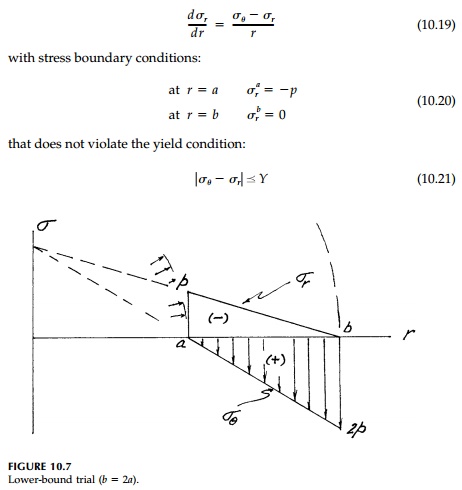Chapter: Civil : Principles of Solid Mechanics : Concepts of Plasticity
The Lower Bound Theorem
The Lower-Bound Theorem
The load corresponding to any stress distribution
throughout the struc-ture, which satisfies equilibrium without violating the
yield condition, is a safe estimate of the limit load.
Another way of stating the theorem is:
Of all internal stress distributions that satisfy
equilibrium and do not vio-late the yield condition, the collapse (limit) load
will be the largest.
When stated the first
way, this theorem is sometimes called ŌĆ£the safe theo-rem.ŌĆØ However, the
limiting process as we approach the correct solution from below, emphasized in
the second version, is the most important concept and therefore the lower-bound
name.
The power of this
theorem for applications is that we do not need to consider the geometry of
deformations but use only stress conditions. There is a straightforward energy
proof of the theorem, but the theorem is intuitively sat-isfying since the
plasticity equations in Section 10.3 also involve only stress and essentially
say the same thing. One important concept, however, which is used in the
classic proof for physical understanding is that, in elastic- plastic theory at
the collapse load, the stresses throughout do not change as the structure
deforms. Thus there are no changes in strain in the ŌĆ£elasticŌĆØ (or not fully
plas-tic) zones during collapse and these regions act essentially as if they
were rigid. Basically, the elastic energy is considered insignificant compared
to the plastic energy as the individual elements move along the horizontal
yield plateau. Similarly for the structure as a whole, the elastic-plastic
energy used getting to the limit state can be disregarded in comparison to the
fully plastic work as col-lapse progresses. Thus, localized areas of intense
shear deformation, called ŌĆ£slip lines,ŌĆØ develop during collapse with the
surrounding materials, in com-parison, acting as rigid blocks sliding relative
to each other. Since the lower-bound theorem deals with stresses (or forces)
and not with deformations (or the failure mechanism), this important concept,
although used in the proof, is not needed in the application of the lower-bound
approach. However, it becomes the crucial consideration in upper-bound analysis
treated in the next section, which in turn, becomes the main focus of succeeding
chapters.
To return to our example of a thick ring in plane
stress under internal pres-sure, let us pretend we do not know the answer and
approach the limit state by applying the lower-bound theorem. We, therefore,
seek a stress distribu-tion satisfying the equilibrium equation (on a
differential scale):

Cutting the ring through any diameter gives another
overall equilibrium rela-tionship in terms of stress resultants:

Clearly any number of possible stress distributions are possible. Our choice is wide open because any distribution of Žār that satisfies the boundary conditions [Equation (10.20)] may be substituted into Equation (10.2) to give the corresponding (Žā╬Ė) and then pL determined so that Equation (10.21) is not violated.
An obvious and simple choice is a linear
distribution as shown in Figure 10.7. For the ring with b 2a:

which satisfies the boundary conditions [Equation
(10.20)]. Substituting into Equation (10.2):

which is also linear and has a maximum value of 2p
at r b. Equation (10.22) is satisfied and since the yield criterion must
not be violated anywhere

This, as we know, is
28% lower than the correct value of 0.693Y, but 33% higher than first
yield.
Obviously to come closer to the exact value we must guess a distribution of Žār and thereby Žā╬Ė that come closer to the yield condition throughout the cross-section. There are obviously better strategies for making educated guesses. One method is to specify Žā╬Ė(r) and determine Žār(r) from the equilibrium equa-tion rather than the other way around. The elastic solution is a very useful clue as to how to proceed, but the lower-bound approach is in no way dependent on knowing the elastic solution beforehand.
Related Topics